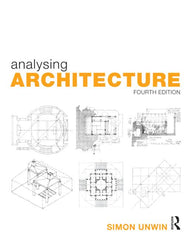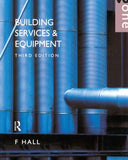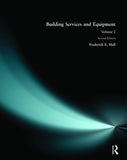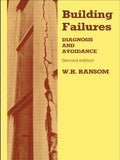Analysing Architecture 4th Edition Simon Unwin
Routledge
Published January 6, 2014
Textbook - 336 Pages - 816 B/W Illustrations
Summary
Now in its fourth edition, Analysing Architecture has become internationally established as the best introduction to architecture. Aimed primarily at those wishing to become professional architects, it also offers those in disciplines related to architecture (from archaeology to stage design, garden design to installation art), a clear and accessible insight into the workings of this rich and fascinating subject. With copious illustrations from his own notebooks, the author dissects examples from around the world and all periods of history to explain underlying strategies in architectural design and show how drawing may be used as a medium for analysis.
This new edition of Analysing Architecture is revised and expanded. Notably, the chapter on ‘Basic Elements of Architecture’ has been enlarged to discuss the ‘powers’ various architectural elements offer the architect. Three new chapters have been added to the section on ‘Themes in Spatial Organisation’, covering ‘Occupying the In-between’, ‘Inhabited Wall’ and ‘Refuge and Prospect’. Two new examples – a Mud House from Kerala, India and the Mongyo-tei (a tea house) from Kyoto, Japan – have been added to the ‘Case Studies’ at the end of the book. The ‘Select Bibliography’ has been expanded and the ‘Index’ revised.
Works of architecture are instruments for managing, orchestrating, modifying our relationship with the world around us. They frame just about everything we do. Architecture is complex, subtle, frustrating… but ultimately extremely rewarding. It can be a difficult discipline to get to grips with; nothing in school quite prepares anyone for the particular demands of an architecture course. But this book will help.
Analysing Architecture is the foundation volume of a series of books by Simon Unwin exploring the workings of architecture. Other books in the series include Twenty Buildings Every Architect Should Understand and Exercises in Architecture.
Table of Contents
Introduction
How Analysis Helps Design
Architecture as Identification of Place
Basic Elements of Architecture
Modifying Elements of Architecture
Elements Doing More Than One Thing
Using Things That Are There
Primitive Place Types
Architecture as Making Frames
Temples and Cottages
Geometries of Being
Ideal Geometry
Themes in Spatial Organisation:
1. Space and Structure
2. Parallel Walls
3. Stratification
4. Transition, Hierarchy, Heart
5. Occupying the In-between
6. Inhabited Wall
7. Refuge and Prospect Postscript 2013 Postscript 1997-2009
Case studies
1. Iron Age House, Castell Henllys, Wales, UK
2. Royal Villa, Knossos, Crete, Greece
3. Llainfadyn, St. Fagans, Wales, UK
4. Mud House, Thiruvananthapuram, Kerala, India
5. Il Tempietto, Rome, Italy
6. Fitzwilliam College Chapel, Cambridge, England, UK
7. Schminke House, Löbau, Germany
8. Vanna Venturi House, Chestnut Hill, Pennsylvania, USA
9. Woodland Chapel, Stockholm, Sweden
10. House VI, Cornwall, Connecticut, USA
11. The Box, Culver City, California, USA
12. Mongyo-Tei (Tea House), Kyoto, Japan
Acknowledgements
Select Bibliography and References
















